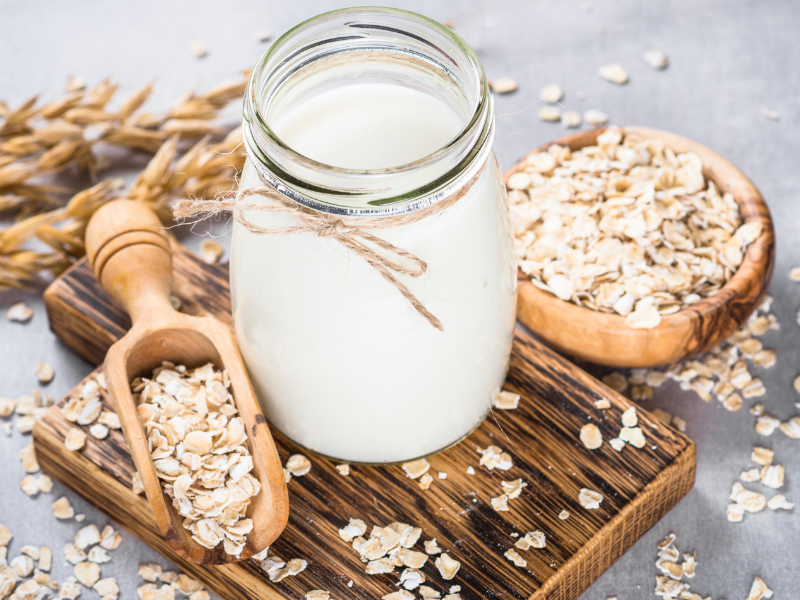Oat milk is one of the most popular plant-based kinds of milk. It’s light and tasty, but it’s hard to find store-bought oat milk that is not full of sugar and chemicals.
This article will show you how to make your oat milk without a cheesecloth in just five minutes! You’ll need a blender, oats, water, and salt for this recipe.
This is an excellent alternative for those who are sensitive to gluten or dairy products!
Oats contain beta-glucans shown in studies to reduce inflammation when consumed regularly.
Oats also contain soluble fiber, which helps lower cholesterol levels by binding with bile acids in the intestines before re-entering the bloodstream.
Making Own Oat Milk
Making your own oat milk is very simple. You will need to place oats, water, and salt in a blender and blend them until they reach the desired consistency.
I like mine to be on the thicker side, but you can make it thinner by adding more water.
Once your oats are blended, pour them into a strainer over the sink or into another bowl with a lid that closes tightly. Then, press down on the oats with a spoon to strain out all liquid.
I recommend storing your oat milk in an airtight container for up to five days. You can also freeze it if you don’t use it within that time frame!
Oat milk is delicious added to breakfast foods like granola and smoothies or used in cow’s milk in recipes.
Get More How to Make Bread Soft (And 9 Reasons It’s Hard)
Storing Oat Milk
After thoroughly making oat milk, you have to store it. I like to use quart-size Mason jars. You can also use a pitcher, but make sure it’s airtight.
Pour your milk into the container of choice and refrigerate immediately.
Oat milk can be stored in an airtight container for up to five days. You can also freeze it if you don’t use it within that time frame!
Oat milk is delicious added to breakfast foods like granola and smoothies or used in place of cow’s milk in recipes.
Check Out How to Make a Green Tea Latte Without Matcha
Tips When Making Oat Milk
There are a few tips that will help you make your oat milk.
First, use cold water to make the milk. Hot water will scald the oats and make them difficult to blend.
Next, do not steep the oats for too long before blending because it will create “rough” oat milk.
Lastly, don’t use too much salt because it can put off flavors if you intend to sweeten the milk with honey or other sweeteners.
Oats are rich in fiber which helps regulate blood sugar levels and cholesterol levels. They also contain beta-glucans shown in studies to reduce inflammation when consumed regularly.
Oats are a great way to start your day, and with this recipe, you can make them quickly and easily at home!
When you buy oats, look for gluten-free if you have celiac disease or gluten intolerance. You can also use steel-cut oats less processed than rolled oats.
Get Out How to Keep Rice Warm (Using a Pot or Rice Cooker)
How to Use Your Oat Milk
Oat milk is great to use in the morning with breakfast foods like fruit or granola. You can also add it to smoothies for extra sweetness and nutrients!
Oat milk makes a delicious addition to coffee too, make sure you warm up your oat milk before adding it so that it doesn’t curdle when it hits the hot coffee.
Oat milk is also great for baking and cooking! It can be swapped in most recipes that call for cow’s or soy milk, but keep in mind that you may need to add a little more liquid if it calls for non-dairy milk.
Some recipes that you can try with oat milk are:
- Oatmeal muffins
- Vegan pancakes
- Chocolate chip cookies
- Quiche Lorraine (replace the cow’s milk with oat milk)
Get More How to Keep Bubble Tea Fresh Overnight
Conclusion,
Making your oat milk is easier than you might think. With a little bit of time and the right ingredients, you can make this delicious dairy-free alternative in no time at all!
Ensure to store it properly by storing it in an airtight container or pitcher that’s been refrigerated for up to five days.
You may also freeze your oat milk if you don’t use it within 5 days so that when needed, thaw out the desired amount before using it again.
Add some oats to breakfast foods like granola or add them into recipes as a substitute for cow’s milk with some adjustment on liquid amounts depending upon how much non-dairy milk was called for in the recipe. These tips should help get you started making oat milk, and remember to enjoy it!

